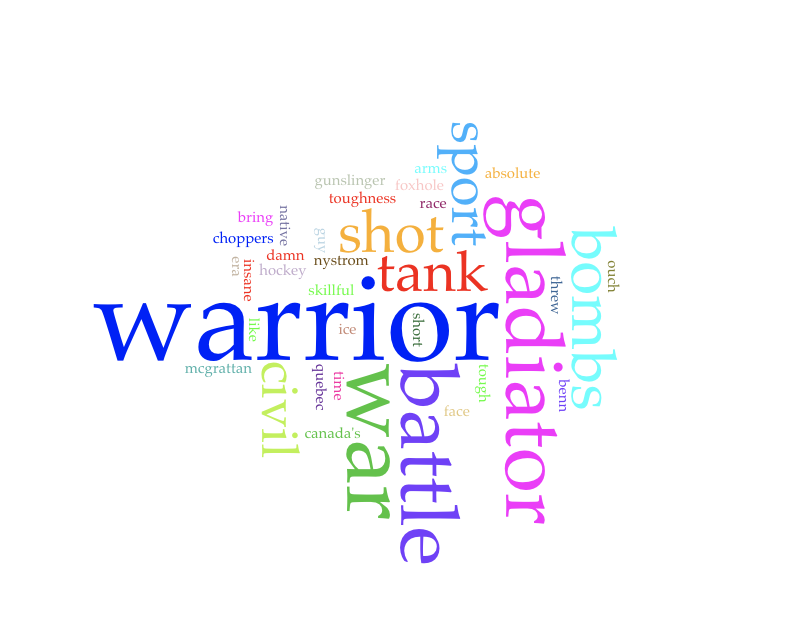One of the most extreme forms of violence present today is war, a traditionally masculine practice. Violence is the largest category of discourse present within the data sample, appearing in 60% of comments. An unexpected theme that arose within this discourse was the theme of war, comments using warlike terminology or even comparing the fights to war. Like feminizing discourse, war is not overwhelmingly present, showing up in 4.1% of comments. In many of these examples commenters used zoomorphism and simile to compare players to animals or objects, this appeared in 14% of comments. There are plenty of times when the two themes overlap.
For instance in the fight between Derrick Boogaard and Brian Mcgrattan one commenter wrote, “McGrattan was a tank,”(“Derek Boogaard vs Brian McGrattan Dec 11, 2009 – Flames feed” 2009). Here Mcgrattan is compared to a vehicle that is commonly used within war, a tank. Within this, the commenter is attempting to emphasize Mcgrattan’s strength, toughness and size, all traits that are seen in tanks.
Using Voyant, the more common phrases found in comparisons to war were identified:

Other examples of war can be found when players are directly described as soldiers. In a fight between Adam Lowry and Ryan Reaves one comment notes, “This sport is insane, absolute warriors and so damn skillful at the same time. 👊🏼👌🏼”(“Adam Lowry vs Ryan Reaves Nov 2, 2019” 2019). In this quote the commenter describes the fighting players as warriors, meaning someone who is engaged in the act of warfare. Again, this is done in an attempt to demonstrate the similar traits that exist within warriors and hockey players, like toughness and bravery. Here, instead of focusing on just the players within the fight, the commenter generalizes this comparison to every player within the sport.
Sometimes simply comparing the players to soldiers wasn’t enough. In the Bob Kelly vs Bob Nystrom fight, one comment read, “If you wanted someone in a foxhole with you during a war, you couldn’t go wrong with a warrior like Nystrom beside you!”(“Bob Kelly vs Bob Nystrom May 24, 1980” 2009). In this quote not only does the commenter call Bob Nystrom a warrior, but claims that he would be an ideal comrade at war. Additionally the comment mentions specific war terminology, using the term foxholes, these are areas that soldiers in past wars would inhabit.
Commmenters also compare the sheer scale of fighting to that of a war; in the bench-clearing brawl between the Quebec Nordiques and Montreal Canadiens, a comment reads, “I think this is the closest thing to a civil war that Canada’s ever had”(“Nordiques vs Canadiens Apr 20, 1984 Good Friday Game” 2010). Because both of these teams are located in Canada, the fight is compared to a civil war. This is due to the size and scale of the fight as nearly every player on each team participated in it. The comparison also could have been made due to the fights’ brutality. In fact, one player was sucker-punched and collapsed unconscious. Other comments reffering to this fight as a war can be better understood within the context of the fight:
Nordiques vs Canadiens Apr 20, 1984 Good Friday Game, Hockeyfights.com, Apr 2010
While fights within the NHL and war are two very different forms of violence, audiences still make sure to note similarities. This was apparent within many different forms of comparison; the fighters as soldiers or weaponry; the fighters valued as soldiers; and the notable scale of violence present. Notably for my research war is seen as a hyper-masculine practice, showing yet another way in which masculinity is present in public opinion. While human life is not usually at stake within hockey fights, participating in them can be costly, putting the presence of violence within this sport in question.